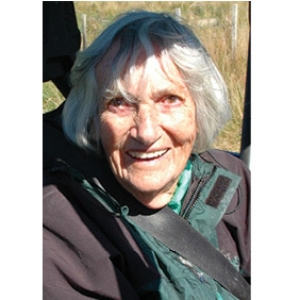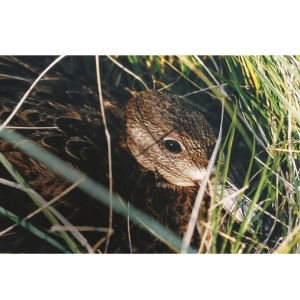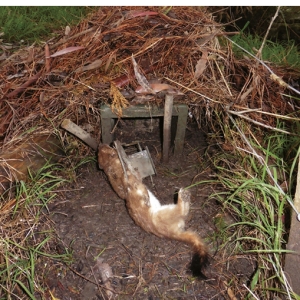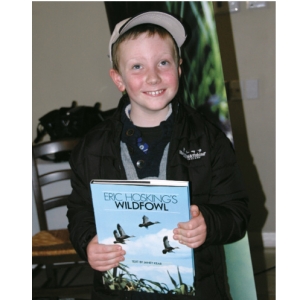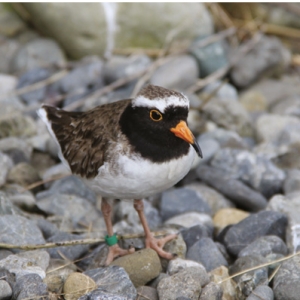Super User
From the President
Obituary Nancy Payne
Nancy Payne passed away recently at 93 years, 31 years of which she had been a Ducks Unlimited NZ member. With the support of her son David and his wife Sheryl, Nancy attended many annual DU conferences the last one being at Martinborough in August 2017. In the past she was known to travel by train from Auckland to Ohakune to attend DU conferences.
Nancy’s interest in wetlands and waterfowl developed as a child when she lived alongside the Waitoa River. She pursued an active life-long interest in natural history and conservation. As well as being a member of DU she had also been active in Forest & Bird, Tongaririo Natural History Society,Auckland Entomology Society and Tiritiri Matangi Supporters Club.
Nancy was in the DUNZ group which attended the DU Canada Convention in Edmonton in 1993. Nancy, somewhat wistfully, considered herself an urbanite because she didn’t have the opportunity to have a wetland of her own. But she was always proud of her involvement with the DU sponsored brown teal programme on Tiritiri Matangi which enabled her to always think of them “as my little ducks”.
John Cheyne
DU Flight NZ Game Bird Habitat Trust
The NZ Game Bird Habitat Stamp programme and the Game Bird Habitat Trust Board play an important role in the protection, enhancement and creation of game bird habitat in New Zealand. While the major focus has been on wetlands, upland game bird habitat is also included. In addition, any improvement of wetlands is also of benefit to a wide range of other wetland birds and fish.
The NZ programme was initiated in 1993 and was based on the programmes operating in Canada and the USA. DUNZ actively supported its establishment. The programme is ably administered by Fish and Game NZ who process the funding applications and provide the secretarial support for the Trust Board.
Board Members
Board members are appointed by the Minister of Conservation on the recommendation of Fish and Game (4 members), Ducks Unlimited (1 member) and a member nominated by the Director General of Conservation.
Current members are:
Andy Tannock – Chairperson (Manawatu), Ian Hogarth (Canterbury, formerly Northland), Mark Sutton (Southland), Steve Cragg (Gisborne), John Cheyne, DU representative (Hawke’s Bay), Susan King, DOC nominee (Malborough).
Functions
The functions of the Trust Board are set out in Section 44D of the Wildlife Act 1953. The Board’s primary focus is applying funds obtained from the Habitat Stamp programme as grants to applicants for the protection, restoration, improvement, creation, or procurement of game bird habitat.
The Board can also:
- Identify and evaluate areas for protection or restoration of habitat
- Negotiate with landowners and other agencies for the protection and restoration of habitat
- Promote or provide advice on protection and restoration of habitat
- Promote the sale of game bird habitat stamps and associated products
- Recommend the game bird or other wildlife species to be depicted on stamp.

_2017_Game_Bird_stamp.png) NZ Game Bird Trust Stamp
NZ Game Bird Trust Stamp
Funding
Funding for the Trust comes from the $3 Game Bird Habitat Stamp, recently increased from $2, from every game bird hunting licence and a proportion of the external sale of stamps to collectors and prints of the annual bird painting. The money raised each year from game bird habitat stamps is transferred from Fish and Game Councils to the Game Bird Habitat Trust. Currently this is approximately $100,000.
Major Projects
The Trust Board is working with wider community interests in implementing a wetland management plan involving a small number of large projects in both the North and South Island. This has included the Para Wetland near Blenheim and Taikitakitoa Wetland near Dunedin
It is currently considering how to help with the JK Donald Block on the north-eastern edge of Lake Wairarapa and the Underwood Wetland near Dargaville. These projects are ranked highly by the Habitat Trust Board for development of a sponsorship package on the basis of game bird and other wildlife habitat enhancement potential.
DU received significant financial assistance from the Trust in developing the Wairio wetland.
Annual Grants
Applications for grants from the Trust close on 30 June each year and are open to anyone with support from the landowner and a recognised habitat referee. Information and forms are available from the Fish and Game NZ website.
This year (2017) the Trust has received 30 applications and these will be considered by the Board when they meet in the Wairarapa 24-25 August. They will also be visiting Wairio wetland during their visit.
Supplied by John Cheyne.
Wetland care New Zealand
Wetland Care
New Zealand

Our business is to harness community, business and government resources to restore and develop lost wetland areas within New Zealand.
Wetland Care members recognise that wetlands are vital to the wellbeing of the environment, acting as huge ecological sponges by soaking up pollutants and filtering water before it reaches streams, rivers, lakes, aquifers and the sea.
Our initiatives focus on matters as far-reaching as groundwater replenishment, flood control, nutrient and contaminant management and climate change – all critical factors for the conservation of freshwater and saltwater wetlands and marshes.
We want to preserve and conserve the flora and fauna of our most endangered ecosystem so that vibrant wetlands are our legacy to future generations.
Funding for projects comes from the Waterfowl and Wetlands Trust established by Ducks Unlimited New Zealand Inc in 1991 and for specific reasons from an assortment of trusts and community based charitable organisations that like our work. Membership donations and corporate memberships also help.
Central to Wetland Care New Zealand’s mission is forming partnerships with people and organisations with similar aims.
Tutukaka Landcare Coalition
Tawharanui Open Sanctuary Society Inc.
Ducks Unlimited Operation Pateke
Port Charles release 2005 at Coromandel
Henley Trust, Masterton
Karori Wildlife Sanctuary, Wellington
Kitchener Park, Feilding
Manawatu Estuary Trust, Foxton
Mangaone Wetland, Raetihi
Masterton Intermediate School
Steyning Trust, Hawke’s Bay
Travis Wetland Trust, Christchurch
Wairo Wetland, South Wairarapa
Wetland Trust New Zealand, Rangiriri
Waitakere Branch Forest and Bird
Yellow-eyed Penguin Trust, Dunedin
Cape Kidnappers pateke release, 2008
and 2009
Fiordland pateke release, 2009.
David Blom elected 43rd President of DUC
Ducks Unlimited Canada (DUC) elected David Blom as its 43rd president at the organisation’s national board of directors’ meeting in Calgary, Alta. The Calgary businessman credits the conservation influences of family and friends for fostering his passion for water, wildlife and the environment. Blom has been volunteering with DUC for more than 30 years.
“I was raised with the attitude that we all have a responsibility to leave the land in a better state than how we found it,” says Blom. “It’s an honour to serve as Ducks Unlimited Canada’s president, and to help lead efforts that are conserving critical natural areas across the country.”
Established in 1938, DUC has been conserving wetlands for 79 years. Wetlands are among the world’s most productive ecosystems. In addition to providing essential habitat for a host of wildlife, they also naturally filter pollutants from water, guard against flooding and drought and store carbon that would otherwise end up in the atmosphere. To date, DUC has secured more than 6.4 million acres through 10,366 habitat projects.
DUC is backed by a conservation community of more than 137,000 people who are taking action in support of wetlands and wildlife. This includes more than 5,900 volunteers who help promote the importance of wetland conservation in the lives of all Canadians. The role of president is DUC’s top volunteer position.
“David brings a tremendous amount of knowledge and experience to the presidential role,” says Karla Guyn, DUC’s chief executive officer. “His business acumen is second-to-none, but most importantly his belief in the mission will inspire others to join us on our conservation journey.”4/12
 David Blom
David Blom
Ducks Unlimited Canada (DUC) is the leader in wetland conservation. A registered charity, DUC partners with government, industry, non-profit organisations and landowners to conserve wetlands that are critical to waterfowl, wildlife and the environment.
For more information, contact:
Ashley Lewis, Communications Specialist, Ducks Unlimited Canada
204-467-3252 (office)
PO Box 1160
204-941-3097 (cell)
Stonewall, Manitoba, Canada.
This email address is being protected from spambots. You need JavaScript enabled to view it.
www.ducks.ca.
Going wild for Canada’s 150th
Ducks Unlimited Canada celebrates by conserving 150,000 acres of important natural habitats
What do you give a country for its 150th birthday? A country renowned for its wildlife and wild places. A country whose heart beats to the rhythm of four distinct seasons. Whose identity is reflected in every shining lake and stream. How about a gift that keeps it this way? A gift of conservation.
A duck in spring - in Canada
Each spring, Canadians herald the sights and sounds of waterfowl as they flock to their nesting grounds. But after their long trips, life for our feathered friends isn’t easy. Ducks – especially females – undergo arduous physical and biological processes before, during and after their journeys. And once here, most hens have one shot to raise a brood.
It’s early June on the Saskatchewan prairies. A slight breeze gives her wings a lift as she circles over a patch of native grassland next to a shallow pond. She decides to land in a small clearing, then walks into the grassy cover. It’s the third spot she’s scouted. She feels safe here.
In the coming days, this blue-winged teal hen will construct a nest with nearby vegetation and line it with down plucked from her breast. She’ll feed on invertebrates to build her energy for an important role: producing a brood.
It’s no easy gig. She’ll need all the energy she has to give.
When male and female waterfowl prepare for their journey from their southern wintering grounds northwards to Canada, they do so in similar ways. The process differs between the sexes once they arrive. David Howerter, PhD, director of national conservation operations at Ducks Unlimited Canada (DUC) explains how, and why ducks do what they do – before and when they get here.
A shared experience: preparing for migration
Feeling restless – Ever wonder what pushes migratory waterfowl to bid adieu to their warm winter homes?
It’s a physiological process called zugunruhe (pronounced: zoo-gun-roo). This German term refers to the restlessness birds experience as migration nears. Zugunruhe is triggered by the endocrine system (a collection of glands that release hormones into their blood stream) in response to longer daylight hours. “As it gets closer to the time for these birds to migrate they become increasingly active,” says Howerter. “They’ll spend more time flying and their movements will begin to orient in the direction they intend to migrate.”
No exceptions – Zugunruhe impacts migratory waterfowl wintering close to the equator, where daylight hours remain consistent, year-round. This may be a result of evolutionary hangover from when the species had a different distribution, or because of the changing angle of the sun.
Packing on the pounds – “Before ducks begin their journey north, they’ll go through a phase biologists refer to as hyperphagia, where they’ll spend a lot of their days consuming calories,” explains Howerter. “This is done to prepare for their long trip.” Like zugunruhe, hyperphagia’s also triggered by hormonal changes, influenced by changing daylight hours.
Growing closer – Migratory waterfowl can only procreate from spring until late summer. This is because in the “off-season” their reproductive organs shrink, making it easier to fly over long distances. As birds close in on their breeding grounds, their endocrine system releases hormones that stimulate their reproductive organs to grow larger again in anticipation of breeding.
It’s all about her: producing a clutch
Once waterfowl arrive at nesting sites, the male-female experience begins to diverge. “Once they have fertilised the eggs and the hen is incubating, the drakes will take off. Often they’ll go further north, to the boreal forest,” says Howerter.
Meanwhile, the hens prepare for one of the most difficult processes they’ll go through in their lifetime: producing a clutch of eggs.
Size matters – How waterfowl behave once they arrive at the nesting site depends on whether they’re capital or income breeders. “Capital” breeders are large-bodied ducks that can store enough energy (calories) to migrate thousands of kilometres and arrive ready to lay a clutch of eggs, and incubate them for about 30 days. One example of a capital breeder is the common eider, which averages between two and six pounds.
“Income” breeders like the far smaller blue-winged teal (weighing in at 400 grams) are unable to sustain the same kind of fuel reserves. When they arrive at the nesting grounds, they’re looking for protein- and calcium-rich foods, like invertebrates, that provide the nutrients they need to produce a clutch of eggs
Medium-size waterfowl like mallards fall somewhere between capital and income breeders. “Birds of average size usually have enough nutrients to initiate the first clutch of eggs, but they don’t have enough reserves to re-nest,” says Howerter. However, some duck species (like mallards, which are persistent re-nesters) will produce a second or third clutch if their first one is unsuccessful.
Nesting is natural – Birds, like people, experience the urge to nest before they welcome offspring into the world. Expectant bird and human parents alike can trace this feeling to the hormone prolactin. Prolactin is released into the blood stream by the pituitary gland, found at the base of the brain.
Laying a clutch of eggs – A hen’s pituitary gland will also release two hormones that stimulate egg production: follicle-stimulating hormone and luteinizing hormone. They trigger ovulation. Once a duck begins to ovulate, a drake can fertilize her egg – then things begin to take shape. “Once the ovum is fertilised the egg starts to develop.
The yolk provides nutrients to the developing embryo and albumen (egg white) is deposited around it, followed by the shell. About seven days later, the hen will lay an egg,” says Howerter.
A blue-winged teal hen will lay between six to 14 eggs, provided she has the energy required to develop them. “Producing a clutch is very energetically expensive,” says Howerter. “In humans, it can be compared to giving birth to an eight-pound baby once a day for nine to 10 days.”
Sitting still – Once a duck has laid her eggs, she will spend nearly one month incubating them. While some ducks, like common eiders, will stay on their nest nearly continuously, other birds take more frequent breaks to eat. “But even they will lose roughly 30 per cent of their body weight,” says Howerter. In some cases, hens may abandon their clutch if conditions become unfavourable (bad weather, predators, disease).
Crack! – The eggs have hatched. Finally, mom can focus on relaxing and refueling, right? “Not exactly,” says Howerter. Instead, she’ll help her ducklings find food high in protein and calcium, required for muscle and skeletal development. While ducklings are precocial (mobile after hatching), they still need help to find suitable habitat and food.
Bidding farewell – After 30 to 40 days, many hens will leave their broods to prepare for moulting (the process in which ducks lose their flight feathers). “The ducklings are on their own after that,” says Howerter, noting at this point young waterfowl are able to source their own food. At a month old, ducklings are also faster and stronger, making them far more difficult for predators like foxes, raccoons, red-tailed hawks and mink to catch and eat.
Back amidst the grasses, the blue-winged teal hen has hatched a healthy brood of ducklings and led them to the nearby wetland. In future years, these ducklings will return to the prairie landscape to produce their own offspring and repeat this fascinating but strenuous process of duck-rearing.
Continuing that cycle depends on a key ingredient, says Howerter. “Good habitat across Canada’s waterfowl breeding grounds is essential to overcoming the many challenges of successful reproduction for returning birds.”
Healthy and plentiful habitat. It’s the best welcome mat we can roll out for waterfowl every spring.
Julielee Stitt
Communications coordinator for Ducks Unlimited Canada.
The need for continual predator control
I run a yearly total as at November 30 each year as part of the excellent initiative of the ‘Swamp Comp’.
For the year ending November 2015 from 6 DoC 200 traps placed around the margins of my wetlands, the list was 11 Weasels, 1 Stoat, 2 Ferrets, 33 Hedgehogs and 7 Rats.
So for the 2016 year where 2 more traps were added in February, with the total of 4 Weasels, and Stoats, 1 Ferret, 12 Hedgehogs and 16 Rats it seemed that we were making a great inroad.
It may seem now that the inroad thought was rather premature, with just under 5 months of the current year run, the total sits at 20 Weasels, 3 Stoats, 7 Hedgehogs and 9 Rats.
The other point is that I have one trap [See photo, note there is an egg, I also bait with the juice from Sardines in spring-water] that is generally located in a central position, with the other traps generally outside of it.
That trap known as Cabbage Tree, has accounted for 15 of the Weasels, 2 Stoats, and 4 Rats, the last one as of April 25.
Possibly the high number may be attributed to the very wet Summer-Autumn where the wetland core which is generally only damp under the Harakeke, Coprosma and Toe Toe associations is this year very wet, so perhaps there is a concentration moving around the dryer margins, however that is only a possible theory as equally the food abundance could be another contributing factor.
Ian Jensen.
Trapping Vermin and Brexit
For those of us with access to habitat, trapping is one very positive way we can tip the odds in the favor of native birds. So why would Britain’s Brexit have anything to do with such important work?
The EU along with Russia and Canada signed up to AIHTS, the Agreement on International Humane Trapping Standards. This binds all member states and Britain was, until Brexit, one of those. The AIHTS agreement is only based on commercial fur-bearing species, and none of the small vermin trapped by British gamekeepers has a commercial value. However stoats in some of those colder signatory countries are commercial when their pelts turn white in winter. These are then known as ermine. This fur has long been used to trim expensive royal robes and similar. While British stoats, (and their NZ descendants), will sometimes turn white, often it is usually only a partial change. So this species has little or no commercial value in Britain which has always imported the ermine it needs. However this collective AIHTS agreement means that Fenn and also body-grip traps, (known in NZ as Conibears), will shortly no longer be approved to catch stoats in the UK. They’re still perfectly legal for weasels and rats, but how do you keep a stoat out of a trapping tunnel set for one of the other species?
The AIHTS agreement might have already put paid to the Fenn and body-grip traps in the UK but Britain successfully negotiated a two year extension, (expiring July 2018), to allow authorities there to find and test suitable alternatives. Brexit also raises the possibility that common sense may again apply. Interestingly the DoC and Goodnature traps made here in NZ are among alternatives, albeit the weight, bulk and expense of these means they are not a direct replacement. But why would the Fenn trap, which has been the gold standard since 1959, fail to meet the new requirements?
Fenn traps work by breaking the backbone of an animal whereas DoC traps inflict a blow to the head. The latter is more or less instant death but the Fenn is sometimes less instant depending on how the animal is caught. In early Fenn trap trials inventor Alan Fenn determined that tunnel height is critical. The animal must not be thrown clear of the trap but must hit the roof and be held there while the traps closes on it. Nor can the tunnel be too low or the trap will expend its energy hitting the tunnel itself, (keeping in mind that the traps tends to jump perhaps 20mm when sprung off). Traps must be recessed and level with the ground and also snugged into the soil, so the animal enters the stable trap straight-on. If used in a wooden trap, the floor needs to be built up level with the trap plate to achieve the same direct animal orientation over the plate. Universal black plastic trap covers in NZ have always been made to fit the larger Mr6 Fenn, not the Mk4. So they are not at all ideal in any critical test. Lastly Fenn traps should be set fine not hard. It is not clear if any of these requirements were factored in to NZ humane trap testing. If just 1 in 20 animals fails to die instantly and takes a minute or so to clinically expire in a Fenn trap, the new standard is breeched. But were all 20 out of 20 traps set wrong?
In this country the stoat was introduced from the UK and also has no commercial value. It is however associated with the decline of many of our iconic native bird species including kiwi especially and also waterfowl. Brown teal, for instance, walk directly to their nest, (rather than fly), which soon leaves a trail that no stoat walking around a pond could miss. This species was one of our most common waterfowl in NZ but soon after the arrival of mustelids, (stoats, weasels and ferrets), their populations collapsed. To this must also be added the destruction of habitat and other factors, but clearly the welfare of stoats in NZ is probably not our highest priority. Or is it?
DoC have recently withdrawn all their thousands of Fenn traps from the field and replaced these with DoC 200, 250 and similar traps to meet new humane standards. Yet DoC use aerial 1080 poison in NZ on a massive scale. This can take up to 18 hours to kill a stoat even in ideal laboratory conditions, so it seems very odd that we should be concerned that 1 in 20 stoats might take a minute to be clinically dead in a steel trap. Perhaps being terribly concerned with traps is a way of offsetting apparent indifference about the wide scale use of aerial poisoning?
What all this means to us kiwis is that the future supply of Fenn traps from the UK is far from assured. This author has spoken to the manufacturer of them in Redditch, who obviously is a worried man. So it would seem that the NZ Government’s goal of a Predator Free NZ in 2050 is off to a very bad start if the standard tool of the British gamekeeper is about to become consigned to museums.
Whether the new DoC and Goodnature traps can be made to do the same job as the Fenn remains to be seen. But if using DoC traps, can I suggest that, if you want to keep playing the piano with a full compliment of fingers, be extremely careful and use the correct safety that should be supplied. At least one Department of Conservation worker was allegedly rushed to hospital having nearly bled-out but for the quick thinking of their work companion.
A tasty morsel.
It is reputed that the cook on Captain Cook’s ‘Endeavour’ had a deal going with the ships cat. He’d let it in the ships hold to catch the rats there, which the chef would cook and eat the rear part of, the cat got the rest. On long voyages, this would have been the only fresh meat available and apparently he thought that with some pepper it tasted quite OK. So there’s an option… if meat is scarce.
John Dyer
2017 AGM/Conference
Yet another well run AGM, with interesting places to visit and plenty of old friends meeting up and catching up.
The auction with Dan Steele as auctioneer ran well, and provided more funds for the coming year. The silent auction also went well, with many interesting items that looked quite fascinating
The AGM on Saturday morning was well attended and run smoothly by members of the DU and other workers.
The trip to Wairio was all in fine weather and the lunch in town (Martinborough) was very tasty.
Finally winding up the day with an excellent dinner and not too far to find our accommodation.
Shore Plover breeding success at Pukaha Mount Bruce
The mission to save more than one endangered bird species has been enriched by last year’s successful breeding programmes at Pukaha Mount Bruce.
The Shore Plover programme saw over 10 birds transported from Pukaha Mt Bruce National Wildlife Centre to Motutapu Island in the Hauraki Gulf and Waikawa Island off the Mahia peninsula (see photo).
The shore plover is in a perilous position with fewer than 200 left in the wild and a history of conservation efforts being hampered by rat infestations. Shore plover were first spotted by observers on Captain Cook’s second voyage to New Zealand.
The shore plover is the most endangered bird reared and cared for at the Pukaha centre. It is very susceptible to mammalian predators; even one rat can cause enormous damage.
Past Department of Conservation attempts to establish shore plover on Mana and Portland Islands were undone by what was thought to be a single rat in both cases.
The breeding and hatching of over 10 chicks at Pukaha had been a real triumph for the staff and wider conservation efforts.
In another success for the breeding programme, over 10 pateke (brown teal) were bred and hatched at the centre in the last breeding season.
The endangered ducks have a wild population of between 2000 and 2500 making them New Zealand’s most rare mainland waterfowl.
As well as great results in the Shore Plover and Pateke recovery programmes, the whio (Blue duck) also produced more than one clutch of ducklings.
Pukaha new free flight aviary that opened in May 2016 enabled the breeding pair of whio that call it home to lay eggs which were then artificially incubated and hand-reared. Those ducks were sent to Turangi where they spent time in a purpose-built environment to prepare them for release to the wild.
The second clutch of eggs is allowed to stay with the parents and be raised naturally. The theory is that by letting the parents raise them, the ducklings will be better parents when it is their time to breed.
Laura Hutchinson - Marketing & Communications.
Pukaha Mount Bruce
027 244 1221
www.Pukaha.org.nz

